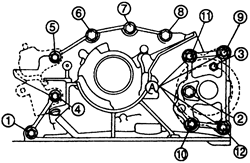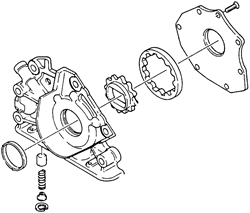

- Before servicing the vehicle, refer to the precautions in the beginning
of this section.
- Remove or disconnect the following:
- Negative battery cable
- Crankshaft pulley
- Timing belt cover and belt
- Crankshaft sprocket
- Oil pan
- Oil pickup tube and discard the gasket
- Oil pump attaching bolts
- Front crankshaft seal from the oil pump, if the pump is being replaced
To install:
- Clean the oil, dirt and old sealant from all contact surfaces.
- If the oil seal was removed from the oil pump, apply clean engine oil to
the lip of the seal. Push the seal in lightly be hand. Press the seal, with
a protrusion of 0.02–0.04 inch (0.5–1.0mm), into the oil pump
with a Seal Installer tool 49 B014 401.
- Apply a bead of silicone to the oil pump at the cylinder block contact surface,
going inside the bolt holes.
- Install or connect the following:
- New O-rings on the oil pump
- Oil pump. Tighten the bolts to 14–18 ft. lbs. (19–25 Nm).
- Oil pump pickup tube, using a new gasket. Tighten the bolts to 70–95
inch lbs. (8–11 Nm).
- Oil pan
- Crankshaft sprocket
- Timing belt and cover
- Crankshaft pulley
- Negative battery cable
- Fill the engine with oil.
- Run the engine and check for leaks.
- Before servicing the vehicle, refer to the precautions in the beginning
of this section.
- Discharge and recover the air conditioning refrigerant.
- Remove or disconnect the following:
- Negative battery cable
- Oil pan
- Air conditioning compressor and bracket
- Power steering pump and tensioner, move the pump aside without disconnecting
the lines
- Crankshaft pulley
- Timing belt cover
- Timing belt
- Crankshaft sprocket
- Oil pump bolts (4 long and 5 short)
- 2 oil strainer-to-pump bolts
- Oil pump body
- Oil seal from the housing
- Oil pump cover and rotors
To install:
- Clean the oil, dirt and old sealant from all contact surfaces.
- Install or connect the following:
- New oil seal by pressing it into the pump housing with a protrusion
of 0–0.03 inch (0–0.7mm)
- Rotors into the oil pump body with the alignment marks aligned
- Pump cover. Tighten the bolts to 53–78 inch lbs. (6–9 Nm).
- Apply a continuous bead of silicone sealant to the oil pump mating surface.
- Install or connect the following:
- Oil pump body. Tighten the bolts to 14–18 ft. lbs. (19–25
Nm).
- New oil strainer-to-pump gasket. Tighten the bolts to 70–95 inch
lbs. (8–11 Nm).
- Crankshaft sprocket and key
- Timing belt
- Timing belt cover
- Crankshaft pulley
- Power steering pump and tensioner. Tighten the 2 tensioner upper bolts
and the power steering pump rear bracket bolt to 33 ft. lbs. (46 Nm).
Tighten the tensioner lower bolt to 18 ft. lbs. (25 Nm).
- Air conditioning compressor bracket. Tighten the bolts to 38 ft. lbs.
(51 Nm).
- Air conditioning compressor. Tighten the bolts to 38 ft. lbs. (51 Nm).
- Oil pan
- Negative battery cable
- Fill the engine with oil.
- Run the engine and check for leaks.
- Evacuate and charge the air conditioning system.
- Before servicing the vehicle, refer to the precautions in the beginning
of this section.
- Remove or disconnect the following:
- Negative battery cable
- Crankshaft pulley
- Timing belt cover.
- Timing belt
- Crankshaft sprocket
- Air conditioning compressor and move it aside, leaving the refrigerant
lines attached
- A/C compressor mounting bracket
- Oil pan
- Oil pickup tube and discard the gasket
- Oil pump body bolts and the oil pump body
- Front crankshaft seal from the oil pump, if the pump is being replaced
- Oil pump cover bolts, cover and rotors, on the 2.0L engine
To install:
- Clean the oil, dirt and old sealant from all contact surfaces.
- If the oil seal was removed from the oil pump, apply clean engine oil to
the lip of the seal. Push the seal in lightly be hand. Press the seal, with
a protrusion of 0–0.02 inch (0–0.5mm), into the oil pump.
- On the 2.0L engine, install or connect the following:
- Oil pump rotors into the pump body with the rotor marks aligned with
each other
- Oil pump cover. Tighten the bolts to 53–78 inch lbs. (6–9
Nm).
- Apply a bead of silicone to the oil pump body-to-cylinder block contact
surface, going inside the bolt holes.
- Install or connect the following:
- New O-rings on the oil pump
- Oil pump body. Tighten the bolts to 14–18 ft. lbs. (19–25
Nm).
- Oil pump pickup tube using a new gasket. Tighten the bolts to 88 inch
lbs. (10 Nm).
- Oil pan
- Air conditioning compressor bracket. Tighten the bolts to 38 ft. lbs.
(52 Nm).
- Air conditioning compressor. Tighten the bolts to 26 ft. lbs. (35 Nm).
- Crankshaft sprocket
- Timing belt
- Timing belt cover
- Crankshaft pulley
- Negative battery cable
- Fill the engine with oil.
- Run the engine and check for leaks.
Due to space requirements, the engine assembly must be removed in order to
replace the oil pump.
- Before servicing the vehicle, refer to the precautions in the beginning
of this section.
- Disconnect the negative battery cable.
CAUTION
Wait at least 90 seconds before performing any work. The backup power supply
system for the Supplemental Restraint System (SRS) must deplete its stored
energy.
- Drain the engine oil and the engine coolant.
- Remove or disconnect the following:
- All electrical connections, hoses and cables necessary to remove the
engine assembly
- Front exhaust pipe
- Engine assembly
- Oil pan
- Oil strainer
- Oil pan baffle
- Timing belt
- Front timing belt pulley and key
- Vacuum pump, if equipped
- Front seal
- Oil pump and discard the O-rings
To install:
- Make sure that the oil pump mating surfaces are clean.
- Install or connect the following:
- New O-rings coated with engine oil in the oil pump cavity
- New oil seal coated with engine oil to the oil pump.
- Apply silicone sealant to the oil pump contact surface.
- Install or connect the following:
- Oil pump. Tighten the bolts, in sequence, to 16–22 ft. lbs. (22–30
Nm) for the "A" bolts and to 14–18 ft. lbs. (19–25 Nm) for
all other bolts.
| Fig. 1: Tightening the oil pump mounting bolts
in sequence — 2.3L and 2.5L engines

|
- Vacuum pump, if equipped, using a new gasket and O-ring
- Key and the timing belt pulley
- Timing belt
- Oil pan baffle
- Oil pump strainer and oil pan
- Engine assembly into the vehicle
- Front exhaust pipe
- All electrical connectors, cables, hoses and any components necessary
to complete the engine installation
- Negative battery cable
- Refill the crankcase and cooling system.
- Start the engine, bleed the cooling system, make any necessary adjustments
- Check for leaks and road test for proper operation.
| Fig. 2: Exploded view of a typical oil pump assembly

|



